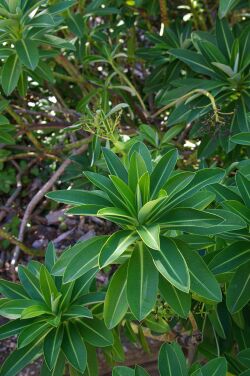Biology:Euphorbia stygiana
| Euphorbia stygiana | |
|---|---|

| |
| Scientific classification | |
| Kingdom: | Plantae |
| Clade: | Tracheophytes |
| Clade: | Angiosperms |
| Clade: | Eudicots |
| Clade: | Rosids |
| Order: | Malpighiales |
| Family: | Euphorbiaceae |
| Genus: | Euphorbia |
| Species: | E. stygiana
|
| Binomial name | |
| Euphorbia stygiana H.C.Watson
| |
| Synonyms[1] | |
| |
Euphorbia stygiana (Portuguese: Trovisco-macho) is a species of evergreen shrub in the family Euphorbiaceae, endemic to several islands of the Azores. It has a critically endangered subspecies (subsp. santamariae) with only 20 known remaining mature individuals in the wild.
Description
Euphorbia stygiana is an evergreen shrub with low but robust serpentine, green stems; white-veined, thick, leathery blue-dark green leaves and large yellow-green flower heads which are strongly honey-scented in spring and summer (from May to June). It can grow up to about 10 metres (33 ft) tall in its native environment but is often 1.5 metres (4.9 ft) tall and spreads to about 1.5 metres (4.9 ft) wide.[2][3][4]
The leaves are 7–14 by 1.5–3.5 centimetres (2.76 in–5.51 in × 0.59 in–1.38 in) long, slightly pubescent on the bottom side. The fruits are 5–7 millimetres (0.20–0.28 in), striated, subglobous and warty.[5] During cold winters (especially outside its native range) these leaves may turn to a brilliant crimson colour.[6]
It is hardy down to USDA Zone 8b: to −9.4 °C (15.1 °F) and can be propagated through stem cuttings.[4]
Distribution and habitat
Euphorbia stygiana is endemic to all Azorean islands except Graciosa where it inhabits the extremely humid highlands of the archipelago from 300 to 1,100 metres (980 to 3,610 ft) in altitude, especially on Pico Island, in sheltered places such as ravines, craters and dense laurel-Juniperus forests.[5][7][8]
Subspecies
There are two known subspecies:
- subsp. santamariae – a critically endangered subspecies native only to the island of Santa Maria with less than 20 known mature individuals remaining in the wild, restricted to 343 square kilometres (132 sq mi). The remaining population rests in a steep slope of a valley embedded in a stream, in a humid forest dominated by Pittosporum undulatum.[9] It is a smaller tree, and has a strong apical dominance. Foliage is less leathery with a faint bluish bloom.[3] It also has a less pronounced leaf vein and has fuzzy inflorescences with orange extrafloral nectaries.[10]
- subsp. stygiana – the most common subspecies, inhabiting most of the Azorean islands except Graciosa and Santa Maria in high altitude, humid laurel-Juniperus forests.[11]
Threats
The species is mainly threatened by agricultural development, change in land use, and invasive species and the subsequent increase in competition.[12]
Toxicity
Like other members of the Euphorbia genus, E. stygiana has a milky white sap that may cause skin irritation or allergic reaction when in contact with the skin or eye.[4] It is toxic if eaten.[2]
Gallery
References
- ↑ "Species Details : Euphorbia stygiana H.C.Watson". Catalogue of Life. http://www.catalogueoflife.org/annual-checklist/2019/details/species/id/ccc46cb9c8810cc5ccff6575230d2903.
- ↑ 2.0 2.1 "Euphorbia stygiana". turn-it-tropical.co.uk. https://www.turn-it-tropical.co.uk/product/euphorbia-stygiana-plug-plant/.
- ↑ 3.0 3.1 "Euphorbia stygiana". panglobalplants.com. http://www.panglobalplants.com/plants-for-sale/exotics/E/1/.
- ↑ 4.0 4.1 4.2 "Euphorbia Species: Euphorbia stygiana". davesgarden.com. https://davesgarden.com/guides/pf/go/168761/#b.
- ↑ 5.0 5.1 "Euphorbia stygiana Watson". Natura 2000 Azores. http://redenatura2000.azores.gov.pt/Web01/fichas/flora/euphorbia_stygiana.htm.
- ↑ "Euphorbia stygiana". rightplants4me.co.uk. https://www.rightplants4me.co.uk/plant/2003.
- ↑ "Euphorbia stygiana H.C.Watson". Flora-on. https://acores.flora-on.pt/#/1euphorbia+stygiana.
- ↑ "Euphorbia stygiana Watson (EUPHORBIACEAE) - Trovisco-macho". siaram.azores.gov.pt. http://siaram.azores.gov.pt/flora/flora-vascular/trovisco/1.html.
- ↑ "Euphorbia stygiana subsp. santamariae H.Schaef.". Flora-on. https://acores.flora-on.pt/#/0-yIx.
- ↑ "O trovisco-macho mais raro da Europa". Paulo V. Araújo, Maria P. Carvalho. https://dias-com-arvores.blogspot.com/2018/06/o-trovisco-macho-mais-raro-da-europa.html.
- ↑ "Euphorbia stygiana". Flora-on. https://acores.flora-on.pt/#/1Euphorbia+stygiana.
- ↑ "Euphorbia stygiana subsp. santamariae". IUCN. https://www.iucnredlist.org/species/162422/120954821.
External links
- Hooker's J. Bot. Kew Gard. Misc. 3: 605 1844.
- The Plant List entry
- Plant Database entry
Wikidata ☰ Q5410581 entry
 |






